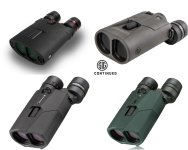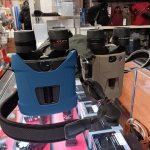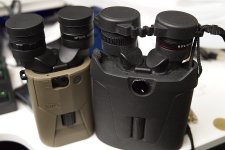Ever since I discovered the Kite APC series on the internet last summer, I couldn't let it go. For my birding trips to the windy coastal areas, I saw a useful role for stabilized binoculars and preferably ones with a slightly longer range. I bought one and took it to the coast for a midweek where it was quite windy (up to wind force 6 from the sea), gray and cloudy, making it an ideal test. Here is my report on my very first steps with the APC 16x42 and its position in relation to my other optics gear. I deliberately chose the 16x because I will mainly use it in wide and open areas. Note: if I had bought them as everyday basic binoculars, I would have taken the 12x42 or even better the smaller 10x30.
Handling
The APC feels solid and fits comfortably in the hand due to its rounded sides and sturdy rubber skin. The weight including 4 batteries is comparable to an average 8x42 binoculars and that is great. I had my doubts about the semi-recessed focus knob beforehand, but it is a fast focusser so very little turning is required and it has a pleasant resistance. The adjustment of the interpupillary distance between the two eyepieces and also the diopter is carried out with a correspondingly strong resistance. The resistance of the round knob for switching on the stabilization is smooth but not too loose and it only needs to be turned a little. It's good that they opted for a rotary knob and not a push button. It is almost impossible to switch it on accidentally, even during storage. The well-fitting eyepiece covers are the kind you see on most binoculars. The wide oval objective hood is a separate item that you will leave at home after a few uses. Because the front glass is recessed enough, I store the APC without the lens hood in the accompanying bag, which in my opinion could have been slightly larger so that the neck strap of the APC fits more easily. Automatically switching off and on from horizontal to vertical is a very useful functionality. In short, the APC is very well put together in terms of design, functionality and operation.
Optical
Due to the small exit pupil of the 16x42, adjusting the eyecups and ocular distance between both eyes requires extra attention. And the eye placement is also always critical and you always have to search a bit. The 12x may be a bit easier in that regard. The sharpness is more than sufficient, but no alpha quality. Personally, I have not really experienced the narrow FOV as a major disadvantage and you certainly do not have the feeling that you are looking through a narrow pipe. The brightness of the 16x42 is good enough, but I sometimes found the contrast a bit substandard. Sometimes some CA is visible but never bothersome and with a very subtle eye shift it disappears immediately. And then... that amazing stabilization... it ensures that all other optical properties do not have to be 100%. Stabilization really gives binoculars added value, I will come back to that later.
Position relative to my other optics
First of all, let me say that both my Zeiss SFL 8x30 and both my Nikon telescopes are better and more attractive in terms of Image Quality than the APC, which is of course not surprising because they are all top optics.
The Zeiss is and will remain my basic everyday binoculars. Due to weight and size, I downsized from the 8x42 to the 8x30/32 size years ago and I have never regretted it.
The large Nikon ED82 telescope with its 30 wide eyepiece has a much greater range than the APC and a beautiful and clear wide image, but in a strong wind at the sea, despite the sturdy carbon tripod, you will still suffer from vibrations. The small Nikon ED50, which I use as a wandering telescope, may have some competition from the APC, but in addition to a better overall IQ, it also has the razor-sharp 13-40 MCII zoom eyepiece with a greater range than the APC. So I think the APC has its own additional position and will mainly be used in very windy conditions in open areas or to quickly scan an area before setting up my large telescope.
Future
You may wonder what can still be improved in the appearance of the well-known brands and what the limited added value is of yet another new model, especially in the top class.
When I exchanged the APC for the Zeiss after half an hour of watching seabirds, I immediately noticed the clear, sharp, high-contrast image of the Zeiss, but I really missed the stabilization. Then you notice how much you shake and move with conventional binoculars, even at 8x. I have noticed that this stabilization makes a contribution to the overall viewing comfort that should not be underestimated. I think that stabilization in a handy binocular could be an attractive added value for many people, even at the usual 8x magnifications. Kite has understood it well with its APC 30 and 42 series ... chapeau, chapeau!
So Swarovski, Zeiss, Leica, Nikon, Kowa and the rest...bring it on!
Handling
The APC feels solid and fits comfortably in the hand due to its rounded sides and sturdy rubber skin. The weight including 4 batteries is comparable to an average 8x42 binoculars and that is great. I had my doubts about the semi-recessed focus knob beforehand, but it is a fast focusser so very little turning is required and it has a pleasant resistance. The adjustment of the interpupillary distance between the two eyepieces and also the diopter is carried out with a correspondingly strong resistance. The resistance of the round knob for switching on the stabilization is smooth but not too loose and it only needs to be turned a little. It's good that they opted for a rotary knob and not a push button. It is almost impossible to switch it on accidentally, even during storage. The well-fitting eyepiece covers are the kind you see on most binoculars. The wide oval objective hood is a separate item that you will leave at home after a few uses. Because the front glass is recessed enough, I store the APC without the lens hood in the accompanying bag, which in my opinion could have been slightly larger so that the neck strap of the APC fits more easily. Automatically switching off and on from horizontal to vertical is a very useful functionality. In short, the APC is very well put together in terms of design, functionality and operation.
Optical
Due to the small exit pupil of the 16x42, adjusting the eyecups and ocular distance between both eyes requires extra attention. And the eye placement is also always critical and you always have to search a bit. The 12x may be a bit easier in that regard. The sharpness is more than sufficient, but no alpha quality. Personally, I have not really experienced the narrow FOV as a major disadvantage and you certainly do not have the feeling that you are looking through a narrow pipe. The brightness of the 16x42 is good enough, but I sometimes found the contrast a bit substandard. Sometimes some CA is visible but never bothersome and with a very subtle eye shift it disappears immediately. And then... that amazing stabilization... it ensures that all other optical properties do not have to be 100%. Stabilization really gives binoculars added value, I will come back to that later.
Position relative to my other optics
First of all, let me say that both my Zeiss SFL 8x30 and both my Nikon telescopes are better and more attractive in terms of Image Quality than the APC, which is of course not surprising because they are all top optics.
The Zeiss is and will remain my basic everyday binoculars. Due to weight and size, I downsized from the 8x42 to the 8x30/32 size years ago and I have never regretted it.
The large Nikon ED82 telescope with its 30 wide eyepiece has a much greater range than the APC and a beautiful and clear wide image, but in a strong wind at the sea, despite the sturdy carbon tripod, you will still suffer from vibrations. The small Nikon ED50, which I use as a wandering telescope, may have some competition from the APC, but in addition to a better overall IQ, it also has the razor-sharp 13-40 MCII zoom eyepiece with a greater range than the APC. So I think the APC has its own additional position and will mainly be used in very windy conditions in open areas or to quickly scan an area before setting up my large telescope.
Future
You may wonder what can still be improved in the appearance of the well-known brands and what the limited added value is of yet another new model, especially in the top class.
When I exchanged the APC for the Zeiss after half an hour of watching seabirds, I immediately noticed the clear, sharp, high-contrast image of the Zeiss, but I really missed the stabilization. Then you notice how much you shake and move with conventional binoculars, even at 8x. I have noticed that this stabilization makes a contribution to the overall viewing comfort that should not be underestimated. I think that stabilization in a handy binocular could be an attractive added value for many people, even at the usual 8x magnifications. Kite has understood it well with its APC 30 and 42 series ... chapeau, chapeau!
So Swarovski, Zeiss, Leica, Nikon, Kowa and the rest...bring it on!











